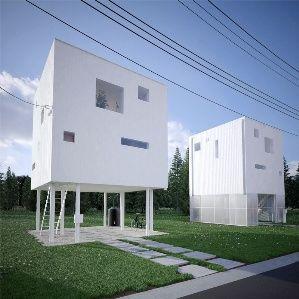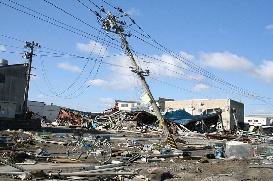Analysis: The slow re-build of Japan
|
Almost 11 months after the Great East Japan Earthquake lifted the seabed 16 storeys and unleashed a tsunami that convulsed Japan, architects and planners are putting together schemes to re-build an exemplary Japan ‘Mark II’ out of the blitzed ruins. But progress is slow. Despite heroic attempts by citizens to start re-building quickly, red-tape, vested-interests and political in-fighting has so far held up the reconstruction process. Unsurprisingly, so too has the level of the destruction and the vast amount of debris left behind in the wake of the tsunami. ‘We are just finding our feet really,’ says Tokyo-based architect Mark Dytham of Klein Dytham architecture. ‘The earthquake and tsunami have made it very difficult to get things like glass, or escalators. A lot of factories supplying architects and developers were affected by the disaster and [nationwide setsuden] subsequent energy savings. Then there’s the knock-on effects from Fukushima – worries about food contamination and water contamination.’ The failure to re-build Tōhoku is first prevented by political stalemate in Tokyo ‘The failure to re-build Tōhoku is first prevented by political stalemate in Tokyo,’ says Kenneth Port, a professor at the William Mitchell College of Law in Minnesota who has a special interest in Japan’s complex property rights. In contrast to the government’s sluggishness, architects were quick to offer their services. Early on in the wake of the catastrophe, a group featuring star architects Toyo Ito, Riken Yamamoto, Hiroshi Naito, Kengo Kuma and Kazuyo Sejima was formed to present various proposals for the reconstruction process and is now pitching in with ideas and blueprints. They all agree that the previous model in Japan, with the private sector controlling nearly all aspects of construction apart from infrastructure, needs to be replaced. ‘Considering the current situation, I don’t believe that renovation through the [existing] initiative is realistic,’ says Japanese architect Kengo Kuma. ‘With the system we have today, public/private partnership under the guidance of central government would not function and would not produce effective results.’ The safety of communities is also paramount to many architects. The present government intends to have new homes built on higher ground by levelling mountainous areas, with residents commuting to fishing ports and fisheries firms along the coast. But that idea has come up against resistance from locals who believe this goes against ties to the sea and jobs they once had. ‘They are very close knit communities,’ says Dytham. ‘They want to be left alone to fathom it out for themselves, so architects have stepped back a little.’ Which means plans, including those to house the 50,000 to 100,000 evacuees from Fukushima in a new environmentally friendly town ‘modelled on a German garden city’ or the building of eco ‘smart towns’ all along the damaged coast, are now on the back burner. Meanwhile, efforts to draw up some kind of practical blueprint for permanently re-building the villages and towns are also being delayed by dithering from boards set up to implement reconstruction. Japanese architect Tadao Ando, who vice-chairs the governmental Reconstruction Design Council, says swift progress has been hampered by ‘endless meetings’. Ando’s offices in Osaka had presented re-building plans as early as April last year, but he says these are still under consideration, stressing that patience is needed. ‘Many are not aware of the scope of the real situation. Reconstruction involves not only the recovery of local houses, but their inhabitant’s entire life-network. The economy of the devastated region is unique for its interdependency upon forestry, agriculture and fishery,’ he says. Those hoping for a phoenix-like rise from the debris led by architects and designers may well be disenchanted. What is happening is a national humiliation Then there are the colossal legal and physical difficulties of re-building on sites washed over by the tsunami. ‘No modern legal system would or could easily deal with entire towns being wiped out in an instant leaving no trace of prior ownership interests and no records of those interests,’ says Port. ‘In some places, the tsunami left 6-10 feet of silt on top of the land, making surveying impossible.’ No doubt the task will be considerable. According to official figures, at least 95,100 buildings have been destroyed, washed away or burnt down. The World Bank estimates the cost at £144 billion, making it the world’s most expensive natural disaster. The total cost of the clean up could be as much as 10 per cent of the country’s current GDP. All this seems to have paralysed decision makers in Tokyo. A low-cost housing model for Japan? We initially drew up this scheme for re-building Tōhoku, in the earthquake-hit region of north east of Japan. However it could be rolled out as a proposition for low-cost housing throughout the country. It is still a work in progress, but the basic idea is to source modular units from the US, where housebuilders are idle, to overcome the inevitable supply and labour bottlenecks up north.
Higher ground is generally uneven and mountainous. Our house can be placed on an easy to install foundation in a few days. There is a good possibility people will try to re-build in tsunami-prone areas so the house can be lifted 2-3 metres off the ground to mitigate future risk. This is only to reduce property loss – evacuation is the key to saving lives.
Photo of Destruction in Japan by Akira Kouchiyama Smart Cities Iwaki-Yumoto, just a few miles from the radiation exclusion zone, typifies many of towns and cities that blight the world’s number three economy. Cruel as the tsunami was, the disaster did at least banish some of Japan’s energy inefficient, jerry-built housing and provide a clean slate for better efforts to accommodate the people of Tōhoku. Above all, say local architects, planners and policy-makers, Japan should harness its tech know-how and build ‘smart cities’ to replace those woefully inadequate car-centric towns that dominate the Japanese lowlands. Smart cities near completion in neighbouring South Korea have taken advantage of IT-controlled power grids and renewable energy. They are wired just as neurons line the human body and their construction is attempting to re-write the way we build cities and our economies. They are hoping to reduce typical emissions by a remarkable 70 per cent. Even before the tsunami, Japan had a couple of smart city projects underway and it is hoped that these carefully planned eco-towns could now be models for the Tōhoku re-build. Panasonic decided to build its 1,000-home experiment when it closed a factory in Fujisawa city, 40km southwest of Tokyo over a year ago. Buildings there will generate their own green energy using a combination of solar power and fuel cells for home – two technologies the electronics giant is pushing hard on the Japanese and global markets. Micro-chipped homes, energy-saving appliances and smart grids will do the rest. Without a proper feed-in system currently in operation in Japan, it is unclear yet what people will do with any excess energy they produce. Hard on the heels of Panasonic are other Japanese electronics behemoths such as Honda, Hitachi and Toshiba. These companies are all hoping that the ‘next big thing’ in construction will be developing what some are calling the ‘internet of things’. This concept sees a wide range of everyday objects easily connected to the internet via radio-frequency identification tags. This allows so-called ‘smart objects, which are predicted to multiply in number exponentially in the coming years, to interact intelligently with their external environment. This what their makers hope will make such urban communities really ‘smart’.
|





